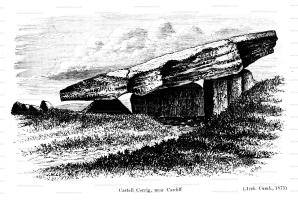Text this colour links to Pages. Text this colour links to Family Trees. Place the mouse over images to see a larger image. Click on paintings to see the painter's Biography Page. Mouse over links for a preview. Move the mouse off the painting or link to close the popup.
Archaeologia Cambrensis 1913 Page 100 is in Archaeologia Cambrensis 1913.

Proceeding past Dyffryn House, formerly known as Worlton, the Cambrians inspected the cromlech and tumulus, ¾ mile to the north at Tinkinswood, where Mr. T. H. Thomas, R.C.A., delivered an instructive lecture on the cromlechs in the district. Dr. Boyd Dawkins was of opinion that they belonged to the Bronze Age, which would make them about 4000 years old. He could not accept the theory of Rev. J. Griffiths of Llangynwyd, that the cromlech had any astronomical bearing, seeing that prehistoric man had no knowledge of astronomy. The weight of the capstone, which is the largest in Great Britain and is supported by four uprights, has been estimated at 55 tons. Its extreme length is 25 feet, its greatest width 16 ft., its average thickness 2 ft. 4 in. There are remains of a large stone circle. In the adjoining field are several other blocks of stone that may be parts of an avenue, or ruined cromlechs, a cistfaen 4 ft. by 2 ft., and about a mile to the north-west on the opposite side of the Cowbridge road to the Cottrell Lodge is a standing stone, probably one of the uprights of a cromlech.1 The smaller, but no less interesting, cromlech at Maes y felin, on the way to St. Lythan's, was also described by Mr. T. H. Thomas. The stone used in the construction of these megalithic monuments is magnesian limestone of the district.